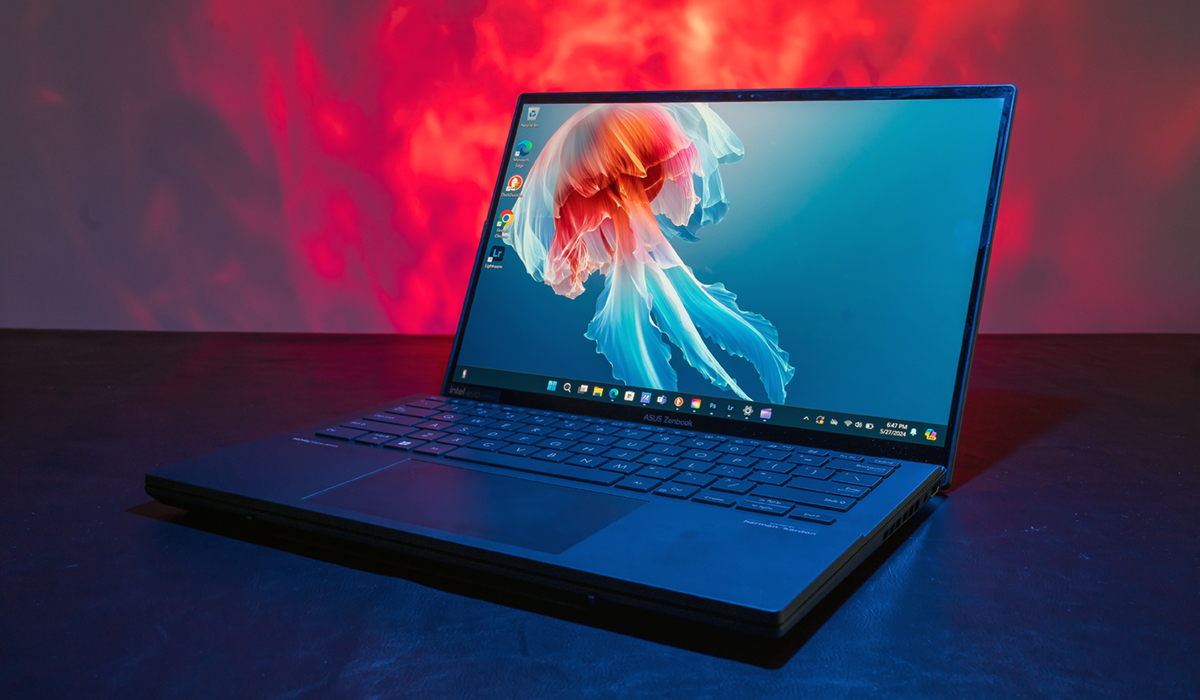
Are two screens better than one? The ASUS Zenbook Duo makes a strong case that doubling screen real estate on a laptop changes how you view them. ASUS hasn’t invented the concept but it’s found ways to make it compelling and usable in ways that matter. After all, simply having two screens doesn’t mean anything if they’re not easy to use and adaptable to different use cases.
The Zenbook Duo manages to pull it off because it’s more than just a showpiece. Matched with solid internal components and flexibility in how to use the laptop, it is one of the more interesting models available. Certainly one of the most interesting laptops I’ve used to date.
ASUS Zenbook Duo (as tested): Display: Dual 14-inch 2880 x 1800 OLED display + 14-inch 1920 x 1200 OLED display
|
Dual-screen design and setup
The centrepieces are the two 14-inch OLED touchscreens, each with the same 1920 x 1200 resolution. ASUS hides the bottom screen under a detachable keyboard and trackpad that you can lift up fairly easily. That keyboard has its own rechargeable battery and works independent of its dock, opening up further flexibility in how to use the two screens. As long as the keyboard is docked, magnetic connectors keep it charged.
This setup makes the lower half of the Zenbook Duo thicker than your average laptop, and there is a small gap between the keyboard and bottom display to protect the latter from any potential harm. Despite the size, you still get a number of ports, including one HDMI, two USB-C Thunderbolt 4, one USB-A and a headphone jack. Notably missing is a memory card slot, which is a shame because of how effective the dual-screen setup can be for creative work. You’d have to use a USB adapter or hub to get a card to work on it.
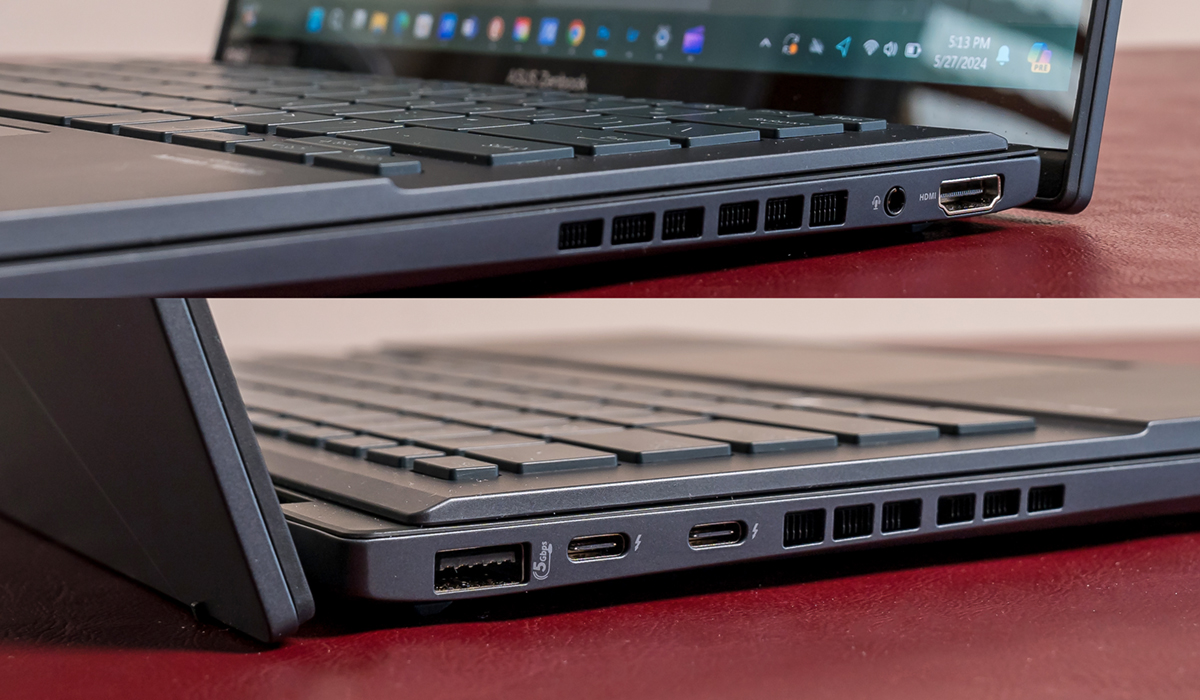
Moreover, while this is a dual-screen hybrid laptop, you can’t move the top screen all the way back 360-degrees. It will lay flat but because of the hinge design, it won’t be flush with the bottom screen. You could also choose to stick out the kickstand attached to the bottom half and prop up both screens in a stacked top-bottom layout. Or you can pull out the kickstand at a 90-degree angle and orient the two screens upright side-to-side. Either way, the height gap between them has a functional purpose in dissipating heat through the vents running along it. That, in turn, helps keep the laptop from getting too hot under the bottom half.
A multitasking presence
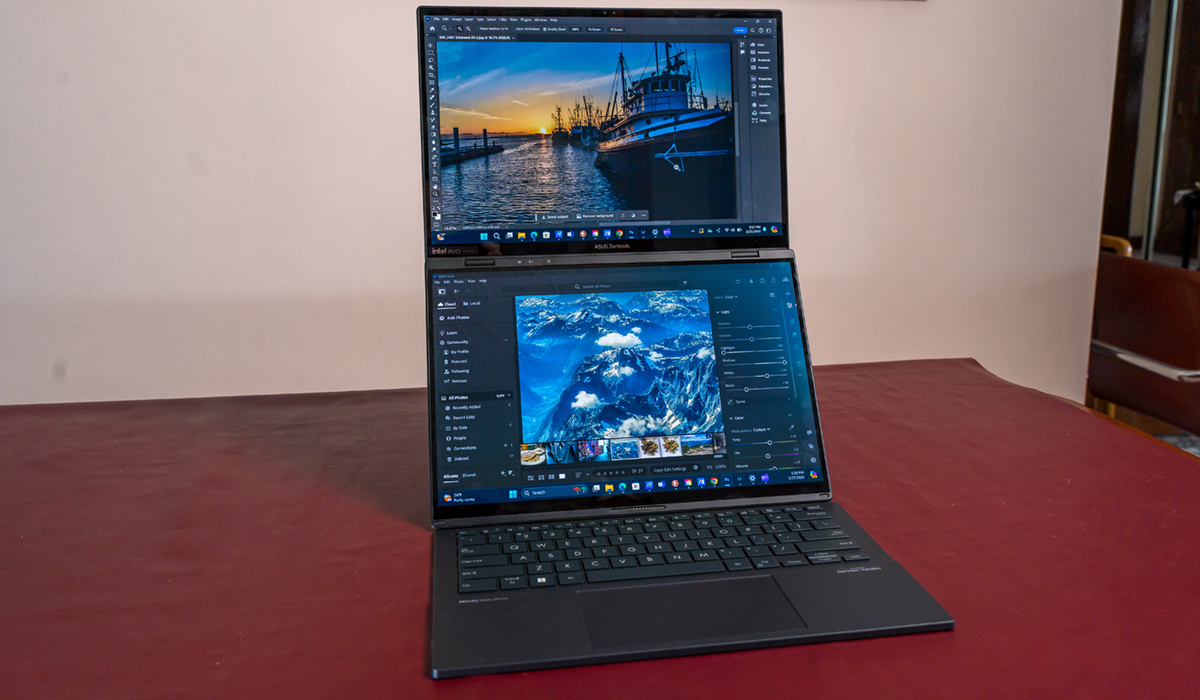
The thing about dual screens is obvious: they let you look at two different things at the same time. Seeing these two screens stacked comes with a major ergonomic advantage in that the top display lines up more with your eyes. I chose to use that one as my main focus with the bottom screen either running a helpful app or to watch something like an NHL or NBA playoff game. In other, more productive cases, I could use the top for word processing and the bottom for research through a web browser. One of my favourites was using Photoshop and Lightroom this way.
What makes this work even smoother is a lack of concern over stability. The kickstand is tough and sturdy, while the hinge between the displays isn’t flimsy at all. The screens just stand up together without issue. Granted, it’s relative to your situation. On a desk or table where nothing is likely going to disturb your setup, you need not worry. But on a plane, train or busier environment, you definitely want some reinforcement wherever you can find it.
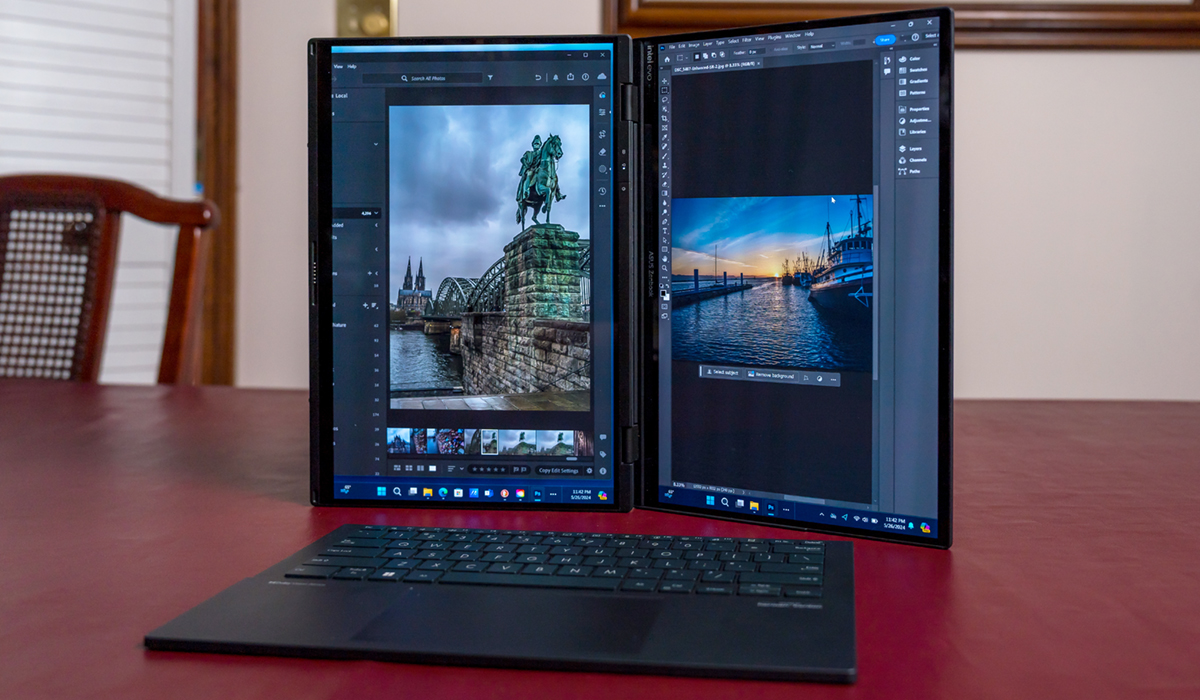
I didn’t personally like the dual portrait orientation as much, feeling it less intuitive. I also didn’t have ASUS’ Pen 2.0 as a stylus to use for more precise photo edits or to jot down notes. There is a Sharing Mode designed to share and mirror your screen with someone opposite you but because there is no way to tilt the displays backward completely, you’re both essentially hunching over to look at them.
One neat trick to preserve some battery life in dual-screen is to turn off the bottom display by pressing the key next to F12 on the keyboard. It will make the screen go blank, leaving the top display active, yet still letting you keep it perched for eye-level viewing. If you plug in and don’t worry about the battery, you could also mirror the displays so that both show you the same thing. There are keyboard shortcuts in the F keys to help speed things up or you can open Settings and go to System -> Display -> and either Duplicate or Extend to get the setup you want.
Another is to utilize the two Thunderbolt 4 ports to connect to another two monitors, giving you four screens to work with in total. That’s a desktop work setup that’s hard to beat.
Performance and expectations
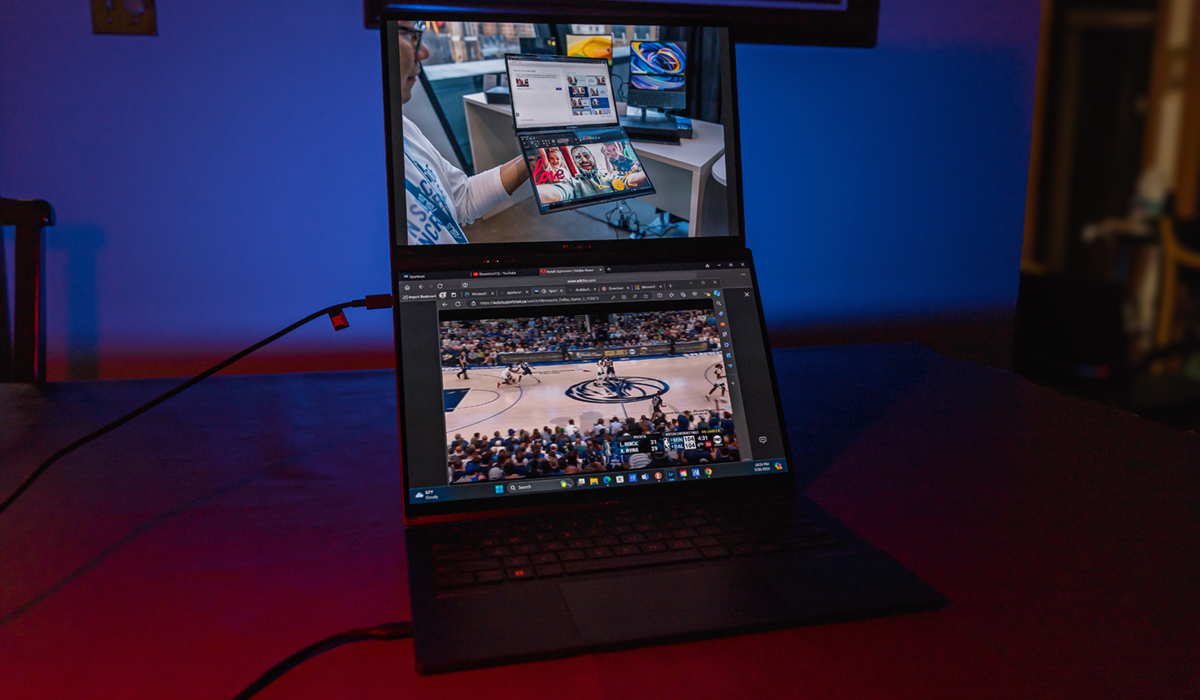
My review unit was equipped with the Intel Core Ultra 7 155H CPU and Intel Arc GPU, making it a pretty capable machine in its own right. Naturally, with integrated graphics, you won’t be mistaking this for a gaming laptop, though that’s clearly not the intention here. For graphics-heavy productivity—think video editing, photo post-production and anything visually creative—the Zenbook Duo accords itself well in getting things done, even if it won’t be as fast as others.
The only thing is colour reproduction won’t necessarily match the accuracy of other OLED panels. It’s a surprise, honestly, because I would’ve assumed ASUS would get that right given its gaming laptop and monitors demand the best. That’s not to say colours look terrible here, just that there is a slightly saturated look to the two displays that can skew what photos and video look like when working on them.
Microsoft’s CoPilot artificial intelligence (AI) platform is hard to miss as an integral part of Windows but I only used it sparingly. A Neural Processing Unit (NPU) can expand on the AI side of things with a focus on how the multitasking and ergonomics matched with the performative elements. You do sacrifice a couple things along the way, like the mediocre speakers and ability to play games fluidly, but the Zenbook Duo never feels like it’s skimping out on anything.
Battery life
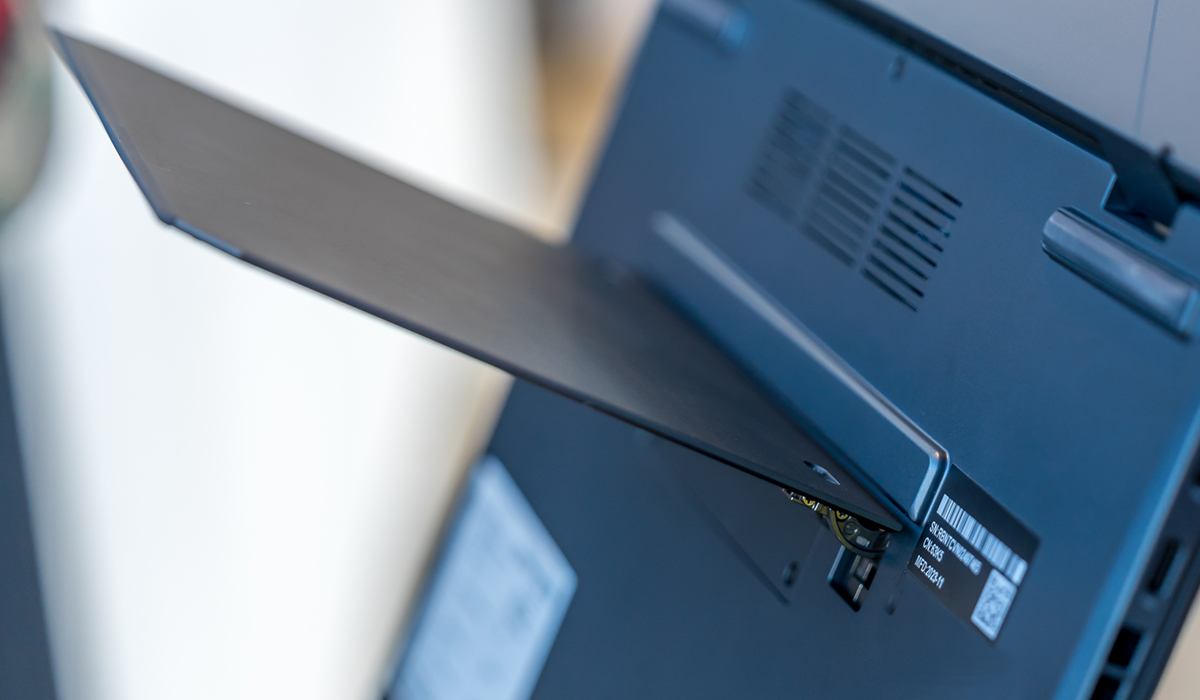
ASUS doesn’t really give you exact estimates on battery life but I can tell you that you should be fine whether you’re using one or both screens. I was able to top 10 hours fairly comfortably with one display, and down to about seven hours with both screens on. A major determining factor is how bright both screens get, which you can adjust through the settings pane.
Those numbers are pretty sufficient for what you get here. It’s always good to know that a dual-screen setup won’t drain the battery in a short time. Moreover, the 65W charger is pretty small and light, so it’s easy to take with you when you need it.
Final thoughts
It’s hard to pull off a dual-screen laptop that impresses under any circumstance, yet the Zenbook Duo succeeds in doing so. It manages to present both screens in functional ways that make a productive difference, which is essential when choosing a device like this. The detachable keyboard may not feel the same as a built-in one but I got used to it, and you can always connect a separate keyboard and mouse if you prefer something different.
Not everything is perfect, though I can’t fault ASUS too much for that because just getting the fundamentals right is paramount. This is more a tool than a toy. You’re not getting this because you want a slick OLED panel to watch movies, you’re getting it because two screens will help you get things done faster and better.
The ASUS Zenbook Duo is available now.





